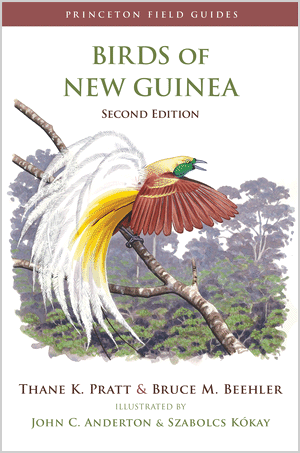
Publisher: Princeton University Press
Publication Year: 2015
Binding: Softback
Page Count: 528
ISBN Number: 978-0-691-09563-9
Price: £ 37.95
Birds of New Guinea - Second Edition
With 780 species, nearly half of which are found nowhere else, New Guinea has to be near the top of any world birder’s list. This remarkable tropical island – the world’s largest – is both geographically and politically complex, and birding the New Guinea ‘mainland’ and its many surrounding islands is logistically and physically challenging. But then perhaps it should be; after all it boasts 37 of the 41 known bird of paradise species, six species of fairywren – all of which are endemic – not to mention some stunning paradise-kingfishers, monarchs and flycatchers.
As you would expect from a book out of the Princeton University Press stable there is plenty of information in here and the species accounts, in particular, have a good degree of depth to them. Although this is the second edition, the book has been significantly updated – the first edition was published nearly three decades ago and it feels more like a handbook to the birds of the region than a typical field guide. I like this kind of approach because it delivers a greater understanding of these birds than the rather superficial treatment seen in many guides. The downside of this approach is the weight of the book – you will be carrying almost the equivalent of a bag of sugar with you!
The book begins with a section introducing the region, its birds and the taxonomy followed, the latter increasingly important these days. This is then followed by an exploration of the geology, climate and vegetation of the region and how the avifauna has been shaped by these. Detail on the 15 ‘bird regions’ within New Guinea provides a valuable overview of where birdwatching efforts may be targeted or, more likely, a bird tour itinerary selected. A useful section on the practicalities of birdwatching the region gives guidance on kit, etiquette, safety, etc.
The 110 plates are generally very good, although one or two are a little cluttered, and each is faced by a small amount of well-presented text and a map for each of the species shown. The shape of the New Guinea mainland (being strongly landscape in orientation) limits the size at which the maps can be produced, but they are certainly readable, and those species with small and restricted distributions are presented cropped in more strongly, which works well. The species accounts, which run from pages 262 to 516, usefully include details on subspecies and taxonomy, though some readers (not me) may question the inclusion of information on, for example, diet and nesting behaviour. All round, this is a solid field guide/handbook and one that does justice to the series.
Book reviewed by Mike Toms






Share this page